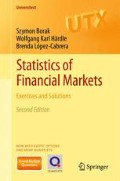Abstract
Financial institutions are interested in loss protection and loan insurance. Thus determining the loss reserves needed to cover the risk stemming from credit portfolios is a major issue in banking. By charging risk premiums a bank can create a loss reserve account which it can exploit to be shielded against losses from defaulted debt. However, it is imperative that these premiums are appropriate to the issued loans and to the credit portfolio risk inherent to the bank. To determine the current risk exposure it is necessary that financial institutions can model the default probabilities for their portfolios of credit instruments appropriately. To begin with, these probabilities can be viewed as independent but it is apparent that it is plausible to drop this assumption and to model possible defaults as correlated events.
Winning is earning, losing is learning.
Access this chapter
Tax calculation will be finalised at checkout
Purchases are for personal use only
References
Breiman, L. (1973). Statistics: With a view towards application. Boston: Houghton Mifflin Company.
Cizek, P., Härdle, W., & Weron, R. (2011). Statistical tools in finance and insurance (2nd ed.). Berlin/Heidelberg: Springer.
Feller, W. (1966). An introduction to probability theory and its application (Vol. 2). New York: Wiley.
Franke, J., Härdle, W., & Hafner, C. (2011). Statistics of financial markets (3rd ed.). Berlin/ Heidelberg: Springer.
Härdle, W., & Simar, L. (2012). Applied multivariate statistical analysis (3rd ed.). Berlin: Springer.
Härdle, W., Müller, M., Sperlich, S., & Werwatz, A. (2004). Nonparametric and semiparametric models. Berlin: Springer.
Harville, D. A. (2001). Matrix algebra: Exercises and solutions. New York: Springer.
Klein, L. R. (1974). A textbook of econometrics (2nd ed., 488 p.). Englewood Cliffs: Prentice Hall.
MacKinnon, J. G. (1991). Critical values for cointegration tests. In R. F. Engle & C. W. J. Granger (Eds.), Long-run economic relationships readings in cointegration (pp. 266–277). New York: Oxford University Press.
Mardia, K. V., Kent, J. T., & Bibby, J. M. (1979). Multivariate analysis. Duluth/London: Academic.
RiskMetrics. (1996). J.P. Morgan/Reuters (4th ed.). RiskMetricsTM.
Serfling, R. J. (2002). Approximation theorems of mathematical statistics. New York: Wiley.
Tsay, R. S. (2002). Analysis of financial time series. New York: Wiley.
Author information
Authors and Affiliations
Rights and permissions
Copyright information
© 2013 Springer-Verlag Berlin Heidelberg
About this chapter
Cite this chapter
Borak, S., Härdle, W.K., López-Cabrera, B. (2013). Portfolio Credit Risk. In: Statistics of Financial Markets. Universitext. Springer, Berlin, Heidelberg. https://doi.org/10.1007/978-3-642-33929-5_18
Download citation
DOI: https://doi.org/10.1007/978-3-642-33929-5_18
Published:
Publisher Name: Springer, Berlin, Heidelberg
Print ISBN: 978-3-642-33928-8
Online ISBN: 978-3-642-33929-5
eBook Packages: Mathematics and StatisticsMathematics and Statistics (R0)

